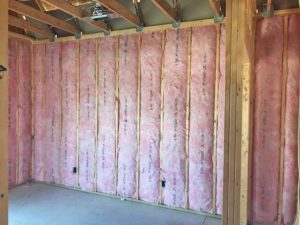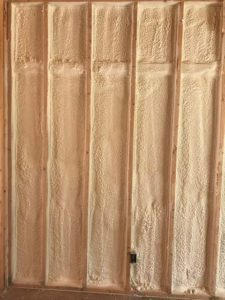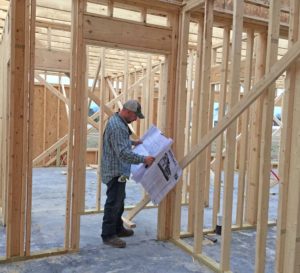What kind of insulation do you recommend?
That depends…. Today everyone is all about green building but not everyone has the budget to go that route.
If I were building my 3,300+ square foot custom built dream home I would be more interested in saving money over the long haul in energy costs and would spend the money up front. For that scenario I recommend 1.5 to 2 inches of sprayed rigid foam insulation followed by blown in rock wool. There are two main reasons that I would go this route. First, the benefit of rigid foam is that it provides a higher R- value per inch than fiberglass or cellulose and it has the added benefit of sealing all air leaks. Of course all this comes with a higher price. The 1.5 inches of the foam seals the openings and then you can fill with the lower cost rock wool blown insulation blanket for a comprehensive energy saving solution.
If you are on a tight budget and this is not your forever home you may be more interested in saving money now on the cost of the insulation than the energy savings down the road. Below are the most frequently used types of insulation in home construction today in eastern North Carolina from lowest cost to highest cost not taking into account the energy savings:
1- Fiberglass insulation comes in either batts or rolls and may be faced with kraft paper, foil kraft paper or vinyl that provides a vapor barrier. Fiberglass insulation is less expensive but requires care to insure it is properly installed between studs, joists and beams. The R-value is very important since it indicates the ability of the insulation to stop heat transfer and the R-value of fiberglass insulation depends heavily on proper installation. You should always remember the higher the R-value the greater the insulating efficiency.
2- Cellulose insulation is mostly made from recycled newsprint and comes primarily in the loose-fill form that will remind you of the lint you remove from your dryer filter. It can be installed in a wall by a dry pack process or a moist spray method. Generally the cellulose is more expensive than batt and provides less air leakage through the wall and improved sound proofing. Cellulose is highly effective in the attic where it settles closer to the heat source and fills cracks. You will find that over time cellulose blown into a wall cavity will settle and leave 2-4 inches of air gap at the top of the wall. Manufacturers typically add chemicals to the cellulose to make it fire and insect resistant.
3- Rock wool insulation is a product made of minerals and about 75% recycled materials. It looks like shag carpet that has been shredded. I use this loose-fill insulation that provides full coverage and is blown into the open stud cavities behind a net. Rock wool is significantly more expensive than the two above options and does not require other chemicals to make it fire resistant.
4- Rigid foam insulation has a higher R-value per inch than fiberglass or cellulose and is best at stopping air leaks.  Rigid foam is up to 5x more expensive than batt and as I mentioned earlier can be sprayed into the cavity. Most rigid foam sprays on as a liquid and once it comes in contact with air it expands to seal off every gap and crack in the wall leaving it airtight. The ability to fill the smallest cavity gives this insullation twice the R-value as traditional fiberglass batt.
Rigid foam is up to 5x more expensive than batt and as I mentioned earlier can be sprayed into the cavity. Most rigid foam sprays on as a liquid and once it comes in contact with air it expands to seal off every gap and crack in the wall leaving it airtight. The ability to fill the smallest cavity gives this insullation twice the R-value as traditional fiberglass batt.
The purpose of insulation is to reduce the heating and cooling costs for your home by reducing heat transfer through the walls and ceiling. I can’t stress enough the importance of insulation, however each homeowner has to evaluate their budget against other priorities for their home.
Tags: Cellulose insulation, fibergalss insulation, how to insulation, How to reduce electric bill, how to save energy, how to save on heating, how to save on utilities, installation of insulation, insulation, Rock wool, Rock wool insulation




